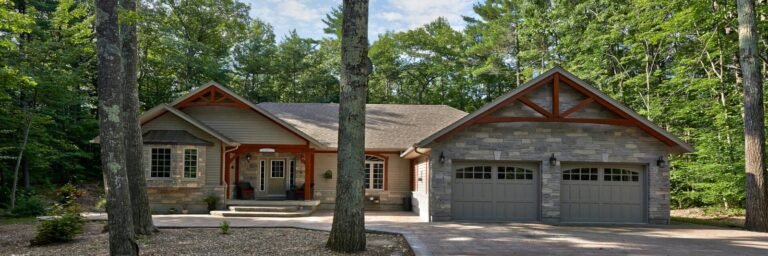
From Dream to Delusion: How Ontario’s Housing Market Became Canada’s Most Expensive Joke
In a twist that would make even the most stoic Canadian drop their double-double, Ontario’s housing market has gone from “expensive” to “you must be joking” in what feels like the time it takes to say “sorry.” The province is facing a housing affordability crisis so severe that buying a home has become less of a milestone and more of a mythical achievement—like spotting Bigfoot or finding a parking spot in downtown Toronto on a Saturday.
Welcome to Ontario: Where Houses Are Like Unicorns
Ontario’s housing crisis has rapidly evolved from a mere economic concern to the political equivalent of the Stanley Cup playoffs—everyone’s invested, emotions are running high, and there’s a lot of checking into the boards. Under Premier Doug Ford’s Progressive Conservative government, re-elected to a second majority in 2022, housing has become a centerpiece of the provincial agenda, with the Premier himself declaring it his “number one priority.”
Recent studies have delivered a financial reality check that hits harder than a Canadian winter: in 11 out of 26 Ontario municipalities analyzed, middle-class households must fork over more than 40% of their monthly income to housing. That’s like going to a restaurant and spending nearly half your meal watching someone else eat your food. Financial advisors recommend housing costs stay below 30% of income, which in today’s Ontario sounds about as realistic as planning a beach vacation in Thunder Bay in January.
Cities like Toronto have become the Hollywood celebrities of unaffordability—famous for being impossible to afford. Ottawa and Hamilton, not wanting to miss the spotlight, have eagerly joined this exclusive club of places where the average person looks at housing prices and thinks, “Maybe I should just build a really nice igloo instead?”
How Did We Get Here? A Comedy of Errors
The housing crisis didn’t happen overnight—though it sometimes feels like we went to bed in affordable Canada and woke up in “Welcome to the Greater Toronto Area, where this shoebox costs $1.2 million.” The crisis is a perfect storm of factors that have been brewing longer than a pot of Tim Hortons coffee left on the burner all day.
At its core is a housing supply shortage so severe it makes PlayStation 5 launches look abundantly stocked. Ontario has been playing a losing game of catch-up with population growth for decades. The province’s population expands faster than builders can say “where do we put all these people?” It’s like trying to fit an NHL team into a minivan—technically possible but nobody’s going to be comfortable.
Restrictive zoning regulations haven’t helped. Many municipalities cling to single-family zoning like it’s the last playoff ticket, creating vast urban areas where building anything denser than a detached home requires an act of municipal courage rarely seen outside of emergency response situations. Local approval processes move at such glacial paces that climate change might eliminate the glaciers before your building permit is approved.
Then there’s the matter of speculative investment, which has transformed housing from “places where people live” to “poker chips in a high-stakes game.” As real estate became Canada’s unofficial national sport (sorry, hockey), investors flooded the market, turning homes into assets and leaving actual home-seekers standing outside in the cold—which, in Ontario, is really, really cold.
Construction costs have soared higher than a Canada goose during migration season, while labor shortages in the building trades have become so acute that spotting an available contractor has become a neighborhood event worthy of a block party. “Look, kids! A plumber with availability this month! Quick, take a picture!”
The Ford Government’s Housing Strategy: Bold Moves and Bulldozers
Since securing their second term in 2022, the Ford government has approached Ontario’s housing crisis with the subtlety of a moose in a china shop. Their flagship housing initiative, the “More Homes Built Faster Act” (Bill 23), represents perhaps the most significant housing policy shift in Ontario’s recent history.
The More Homes Built Faster Act: Doug’s Housing Hammer
Bill 23 burst onto the scene in late 2022 with the enthusiasm of a Leafs fan who thinks this might finally be the year. The legislation aims to build 1.5 million homes by 2031, a target so ambitious it makes climbing Everest look like a casual weekend hike.
The act takes a bulldozer to municipal barriers, reducing development charges, shortening approval timelines, and overriding local zoning rules that have traditionally kept density at bay. It’s essentially the provincial government saying to municipalities, “We asked nicely for years—now we’re taking the wheel.”
Critics argue the bill gives developers a “get out of fees free” card without guaranteeing affordability. Environmental advocates worry about its impacts on conservation authorities and greenbelts, suggesting that solving the housing crisis by paving over wetlands is like fixing a leaky roof by removing the roof entirely.
The Greenbelt Controversy: Political Hot Potato
No discussion of the Ford government’s housing approach would be complete without mentioning the Greenbelt controversy—a political saga with more plot twists than a Canadian Netflix original. After promising not to touch the protected Greenbelt lands during his campaign, Ford executed a dramatic policy pirouette in 2022, announcing plans to open portions for housing development.
The ensuing political firestorm resulted in the resignation of two cabinet ministers, a housing minister, and Ford’s chief of staff—essentially the political equivalent of trading away your starting lineup mid-season. Following investigations by the provincial auditor general and integrity commissioner that found the process “favored certain developers,” Ford performed another reversal in 2023, announcing the lands would remain protected after all.
This Greenbelt dance not only damaged political trust but also distracted from the broader housing agenda, proving once again that in Canadian politics, environmental issues can be as treacherous as black ice on the Trans-Canada Highway.
Municipal Zoning Overhaul: Density, Ready or Not
One of the Ford government’s more consequential moves has been forcing municipalities to accept higher density development around transit stations through Transit-Oriented Communities (TOC) legislation. This approach tells cities, “You got the subway station you wanted; now you’re getting the apartment buildings that come with it.”
The province has also eliminated exclusionary single-family zoning in major municipalities, allowing up to three units on lots previously restricted to single detached homes. It’s like telling your picky eater child that yes, there will be vegetables on their plate, and no, chicken nuggets are not a vegetable.
While urbanists and housing advocates cheer these changes as long overdue, some municipal leaders and neighborhood associations have reacted as if the province suggested replacing hockey with badminton as the national sport.
When Housing Costs Too Much: Life Changes That Nobody Asked For
Ontario’s housing crisis forces lifestyle changes more dramatic than when you decide to finally try that new haircut. Individuals and families make sacrifices that previous generations would find baffling, like:
- Moving so far from work that “commute” becomes a part-time job itself
- Living with roommates well into one’s 40s, turning “Golden Girls” from a sitcom into a housing strategy
- Delaying family formation, because who needs a nursery when you can barely afford a closet?
- Converting living rooms into bedrooms, dining rooms into home offices, and bathrooms into—well, bathrooms are pretty much stuck being bathrooms
These adaptations impact quality of life more profoundly than discovering Tim Hortons changed their coffee recipe. Long commutes contribute to urban sprawl, infrastructure strain, and environmental degradation—not to mention the psychological toll of spending more time with strangers on public transit than with your own family.
The crisis disproportionately affects lower-income households, minorities, and younger generations, creating socioeconomic disparities wider than Lake Ontario. Without intervention, Ontario risks creating a province where housing security depends more on when you were born or who your parents are than on your own efforts and contributions.
Opposition and Alternative Approaches: The Road Not Yet Taken
The opposition parties in Ontario haven’t been shy about offering their own housing prescriptions. The NDP, now led by Marit Stiles after Andrea Horwath’s departure, has proposed a suite of policies that makes the Ford approach look as conservative as a church bake sale.
The NDP platform includes a return to comprehensive rent control, a speculation tax aimed at cooling investor frenzy, and significant public investment in non-market housing. It’s essentially saying, “The market got us into this mess, so maybe the market isn’t the solution”—a perspective that makes free-market enthusiasts clutch their Adam Smith books a little tighter.
The Ontario Liberals, still in rebuilding mode after their 2022 electoral drubbing that left them with fewer seats than a compact car, have centered their housing approach on “gentle density” and transit-oriented communities. They’ve criticized Ford’s developer-friendly approach while proposing a middle path that tries to increase supply without steamrolling municipal concerns or environmental protections.
Meanwhile, municipal leaders like Toronto Mayor Olivia Chow have been promoting their own housing solutions, focusing on protecting renters and creating deeply affordable housing. This creates a multi-level government housing policy environment about as harmonious as three hockey teams sharing one rink.
Early Results: Are We Building More Homes Yet?
The million-dollar question (or in Toronto terms, the two-million-dollar question) is whether the Ford government’s ambitious housing agenda is actually producing results. Early evidence suggests a mixed scorecard.
Housing starts in Ontario have shown some encouraging signs, with multi-family construction seeing particular growth. However, the province remains well below the pace needed to hit that 1.5 million homes target, which increasingly looks like promising to lose 50 pounds while increasing your daily Tim Hortons intake.
The pandemic, rising interest rates, and construction costs have all complicated the picture, creating headwinds strong enough to make even the most determined developer consider a career change. Labor shortages continue to constrain building capacity, with skilled trades workers now treated with the reverence once reserved for NHL all-stars.
Municipal approval processes, despite provincial pressure, still move at speeds that make glaciers look hasty. The tension between provincial mandates and local control creates an implementation gap wide enough to drive a cement truck through—if you could find someone to drive it, that is.
Solutions That Might Actually Work (No, Really)
Solving Ontario’s housing crisis requires a multifaceted approach more complex than the instructions for assembling Swedish furniture. Effective strategies must balance immediate affordability concerns with long-term structural changes—a policy tightrope walk that makes actual circus performers seem risk-averse.
Beyond the current government initiatives, experts point to several approaches that could further address the housing shortage:
- Skilled trades investment: Addressing labor shortages through enhanced education and immigration pathways for construction workers could remove a critical bottleneck.
- Purpose-built rental incentives: Creating specific incentives for purpose-built rental construction would help address the supply shortage in the rental market, giving tenants more options than just basement apartments with ceilings so low they qualify as neck exercise equipment.
- Public land development: Utilizing provincially and municipally owned lands for affordable housing development could bypass land cost barriers that make affordability as rare as a quiet moment during a hockey playoff.
- Co-housing and alternative models: Supporting innovative housing forms including co-housing, community land trusts, and multi-generational housing could create affordable options outside traditional market mechanisms.
- Infrastructure coordination: Better aligning infrastructure investments with housing growth could prevent the “build first, figure out roads and transit later” approach that has created communities where “walkable” means “technically possible if you have all day and really good boots.”
What Will Our Housing Future Look Like?
The outcome of Ontario’s housing crisis will shape the province’s identity more profoundly than any “Visit Ontario” tourism campaign ever could. Will future generations look back at this period as the pivotal moment when Ontario addressed its housing challenges, or as the time when homeownership became a historical concept studied alongside dial-up internet and VHS tapes?
The Ford government has at least three more years to implement its housing agenda before facing voters again in 2026. That’s enough time to either make meaningful progress toward housing affordability or to firmly cement their housing legacy as another entry in the “we tried” category of Canadian policy attempts.
If meaningful reforms take hold, we might see a renaissance of housing innovation—multi-generational homes, co-housing communities, converted commercial spaces, and density that creates vibrant neighborhoods rather than just cramming more people into less space. The “missing middle” housing types—duplexes, triplexes, townhomes, and low-rise apartments—could return from their policy-induced extinction, creating communities as diverse as the population they house.
Without effective implementation, the alternative is a province increasingly divided between property owners and permanent renters, where housing wealth drives inequality more powerfully than education or occupation. Young Ontarians might join a diaspora seeking affordability in other provinces or countries, taking their talents, tax contributions, and Tim Hortons patronage with them.
Conclusion: This House is Not a Home (Yet)
Ontario stands at a housing crossroads, with Premier Ford’s second term representing a crucial period in the province’s development. The crisis demands urgent, innovative, and decisive policy action—the kind that future high school history students might actually find interesting to learn about.
Effective solutions require not just strong political will but extensive collaboration among governments, private sector entities, and communities. The province needs to channel its legendary winter resilience into housing policy determination, creating solutions as reliable as a Canadian apologizing after someone else steps on their foot.
As the Ford government continues implementing its housing strategy, the stakes extend beyond political fortunes to the very character and functionality of Ontario society. Will the province become known for solving its housing crisis, or will “unaffordable Ontario” become as much a part of its identity as maple syrup and politeness?
The answers will shape not just where Ontarians live, but how they live—determining whether the Canadian dream of homeownership remains attainable or joins the ranks of childhood aspirations like becoming an astronaut or professional hockey player. For a province that prides itself on pragmatism and inclusion, the housing crisis represents both its greatest challenge and its most significant opportunity to demonstrate those values in action.
In the meantime, if anyone needs me, I’ll be looking at real estate listings in New Brunswick and trying to convince myself that extreme winters build character.
Sources:
https://globalnews.ca/news/11109314/report-housing-crisis-ontario/
https://www.cbc.ca/lite/story/1.7492890
https://realestatemagazine.ca/capital-construction-and-control-why-housing-policy-could-define-the-2025-election/
We’d love to hear your thoughts! Please leave a comment below if you agree, disagree, or have any questions about the topic. If you need additional information or want to continue the conversation, don’t hesitate to contact us. And for more insights and how-to guides, feel free to explore the links below or head over to our “The Workbench” page. We look forward to hearing from you!



